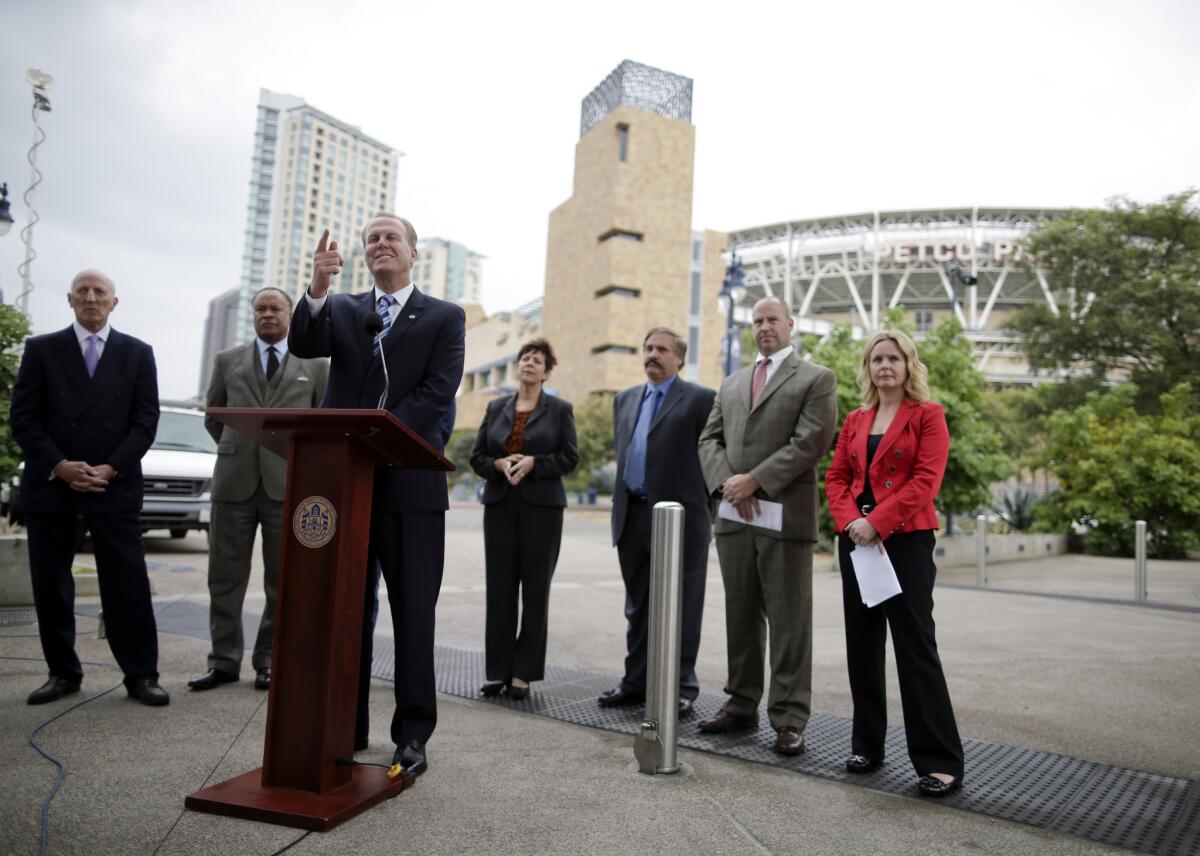San Diego pumps up efforts to keep Chargers from moving to L.A.

- Share via
Reporting from San Diego — San Diego Mayor Kevin Faulconer on Friday named nine business and civic leaders to a committee tasked with devising a plan to build a football stadium that would keep the Chargers from moving to Los Angeles.
Faulconer gave the committee until fall to locate a site and put together a financing plan to submit to voters. He also narrowed the possible sites to two: the eastern edge of downtown and the Mission Valley location of Qualcomm Stadium.
While the Chargers have sought for more than a decade to convince San Diego officials that the team needs a new stadium, the urgency of that request has recently increased. The owner of the St. Louis Rams has joined a partnership to build a stadium in Inglewood, a precursor to possibly moving the Rams to Los Angeles.
With no pro team of its own, Los Angeles County -- along with Orange County and the Inland Empire -- has become a “secondary market” for the Chargers. A team in Los Angeles could slice into that market and the Chargers’ profitability.
The possibility of the Chargers moving to Los Angeles has never “been more real,” Faulconer said at a news conference outside Petco Park, the venue for the Padres baseball team.
Petco Park, Faulconer said, “is a perfect example of what we, as San Diegans, can accomplish when we work together.”
San Diego voters voted by 60% in 1998 for a redevelopment plan that included a baseball stadium so the Padres could depart Qualcomm.
But the political and financial factors have changed.
The Petco Park deal did not require a two-thirds vote for passage. Opposition to using public funds for a Chargers stadium is likely to be stronger and more widespread than opposition to Proposition C on the November 1998 ballot.
Faulconer has stopped short of saying that he would oppose any use of public funds -- either through taxation or a land deal.
Rather, he repeated on Friday that the financing “must be a good and fair deal for San Diego taxpayers.” The definition of good and fair remains opaque.
Whether a financing plan can be devised that does not require two-thirds approval -- and could withstand legal challenge -- remains unclear. Sixteen lawsuits were filed over the Petco Park financing.
Under their lease to use city-owned Qualcomm, the Chargers can leave at will. The team has indicated it will remain for the 2015 season but has left open the issue of moving for 2016.
“The Chargers have been working on stadium solutions in San Diego for the last 13 years, and we have already committed to continuing that work for a 14th year in 2015,” Chargers special counsel Mark Fabiani said in a statement released after Faulconer’s announcement.
“We will be happy to share with the mayor’s new task force the nine different stadium proposals the Chargers have made over the years, as well as the ideas produced [a decade ago] by another city-appointed task force and by two separate outside experts hired by the city during this period.”
The Chargers’ preferred plan is a combination stadium and convention center annex several blocks from the city’s waterfront convention center.
But that plan collides with a preferred plan of the City Council and the politically powerful hotel industry for an expansion that is contiguous to the convention center.
Expansion is seen as necessary to keep Comic-Con and other heavily attended conventions from moving from San Diego in search of a larger venue in cities such as Anaheim or Los Angeles.
Named to the committee by Faulconer were a construction company chairman, a private equity investor, assistant manager of the Sycuan Indian tribe, a leasing company executive, an official with the Chamber of Commerce, a former chief administrative officer with the county government, an executive with Sempra Energy, and the executive director of the Urban Land Institute.
Also named to the committee was Jim Steeg, a former NFL executive credited with the growth in popularity of the Super Bowl.
“We’re going to have a real, tangible plan for a new stadium for the first time,” Faulconer said. “San Diegans are going to be able to see it, kick the tires, and, in the end, voters will have the final say.”
Twitter: @LATsandiego
More to Read
Sign up for Essential California
The most important California stories and recommendations in your inbox every morning.
You may occasionally receive promotional content from the Los Angeles Times.










